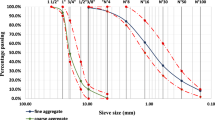Abstract
The high-flowing sand-concrete (HFSC) containing natural sands as aggregate was carried out. The high fluidity and stability of HFSC can be achieved by tailoring the mix design parameters, such as fine to coarse sand ratio, dosage of additions, water to binder ratio and dosage of admixtures. Mini-cone slump test, v-funnel time test and viscosity model parameters were used to characterize the behaviour of HFSC in fresh state. The mechanical compressive strength in 28 d was also determined. A factorial design approach was used to establish models highlighting the effect of each mix-parameter on measured properties of HFSC. The derived models are valid for mixtures made with 0 to 0.3 of dune sand to total sand ratio, 82 to 418 kg/m3 of marble powder, 0.42 to 0.46 of water/binder ratio and 1.3% to 1.9% of superplasticizer high water-reducer. The results show that the derived models constitute very efficient means for understanding the influence of key mix-parameters on HFSC properties and are useful in selecting the optimum mix proportions, by simulating their impact on fluidity, stability and compressive strength.
Similar content being viewed by others
References
BOUDAOUD Z, BREYSSE D. Study of the effects of cogrinding of sand and clinker on the properties of sandcrete [J]. Materials and Structures, 2002, 35(5): 310–316.
BÉDÉRINA M, KHENFER M M, DHEILLY R M, QUÉNEUDEC M. Reuse of local sand: Effect of limestone filler proportion on the rheological and mechanical properties of different sand concretes [J]. Cement and Concrete Research, 2005, 35(6): 1172–1179.
HUA C, CRUZ X, EHRLACHER A. Thin sand concrete plate of high resistance in traction [J]. Materials and Structures, 1995, 28(9): 550–553.
KHAYAT K H, HU C, MONTY H. Stability of self-consolidating concrete, advantages, and potential applications [C]// Proceedings PRO7 of the first International RILEM Symposium on Self-Compacting Concrete, Stockholm: R1LEM Publications, 1999: 143–152.
KHAYAT K H, GHEZAL A, HADRICHE M S. Factorial design models for proportioning self- consolidating concrete [J]. Materials and Structures, 1999, 32(9): 679–686.
YAHIA A, KHAYAT K H. Experiment design to evaluate interaction of high-range water-reducer and antiwashout admixture in high-performance cement grout [J]. Cement and Concrete Research, 2001, 31(5): 749–757.
COLLEPARDI M, COLLEPARDI S, TROLI R. Properties of SCC and flowing concrete [C]// Proceedings of the International Conference of Sustainable Construction Materials and Technologies, Coventry: Pub. UW Milwaukee CBU, 2007: 25–31.
ZHU W, GIBBS J C. Use of different limestone and chalk powders in self-compacting concrete [J]. Cement and Concrete Research, 2005, 35(8): 1457–1462.
ZHENG Jian-lan, WANG Xue-fang. Influence of fly ash on early-age cracking behavior of high-flowing concrete [J]. Journal of Central South University of Technology, 2009, 16(2): 312–319.
FELEKOĞLU B. Optimization of self-compacting filling grout mixtures for repair purposes [J]. Construction and Building Materials, 2008, 22(4): 660–667.
BROUWERS H J H, RADIX H J. Self-compacting concrete: the role of the particle size distribution [C]// Proceedings of First International Symposium on Design, Performance and Use of SCC, Hunan, China: R1LEM Publications, 2005: 109–118.
SABLOCRETE, Synthèse du Projet National de Recherche et Développement. Bétons de sable: caractéristiques et pratiques d’utilisation [M]. Paris: Presse de l’école Nationale des Ponts et Chaussées, 1994. (in French)
KHAYAT K H, SONEBI M, YAHIA A, SKAGGS C B. Statistical models to predict flowability, washout resistance and strength of underwater concrete [C]// Proceedings of the International RILEM Conference on Production Methods and Workability of Concrete, France: R1LEM Publications, 1996: 463–481.
KHAYAT K H, GHEZAL A, HADRICHE M S. Utility of statistical models in proportioning self-consolidating concrete [J]. Materials and Structures, 2000, 33(5): 338–344.
SONEBI M. Factorial design modelling of mix proportion parameters of underwater composite cement grouts [J]. Cement and Concrete Research, 2001, 31(11): 1553–1560.
NEHDI M L, SUMMER J. Optimization of ternary cementitious mortar blends using factorial experimental plans [J]. Materials and Structures, 2002, 35(8): 495–503.
NUNES S, FIGUEIRAS H, OLIVEIRA P M, COUTINHO J S, FIGUEIRAS J. A methodology to assess robustness of SCC mixtures [J]. Cement and Concrete Research, 2006, 36(12): 2115–2122.
GOUPY J, CREIGHTON L. Introduction to design of experiments with JMP examples, Third edition [M]. Cary, NC: SAS Institute Inc, 2007.
AFNOR Standards. Béton et constituants des bétons, Tome1: Spécification du béton et de ses constituants [M]. Paris: 5ème Édition, Recueil des Normes: Bätiment et travaux publics, 2002. (in French)
AFNOR Standards. Ciments et chaux [M]. Paris: Recueil des Normes: Bätiment et travaux publics, 2003.(in French)
EFNARC. Specification and Guidelines for self-compacting concrete [R]. The European Federation of Specialist Construction Chemicals and Concrete Systems, 2002.
FELEKOĞLU B, TOSUN K, BARADAN B, ALTUN A, UYULGAN B. The effect of fly ash and limestone fillers on the viscosity and compressive strength of self-compacting repair mortars [J]. Cement and Concrete Research, 2006, 36(9): 1719–1726.
GÜNEYISI E, GESOĞLU M. Properties of self-compacting mortars with binary and ternary cementitious blends of fly ash and metakaolin [J]. Materials and. Structures, 2008, 41(9): 1519–1531.
GÜNEYISI E, GESOĞLU M, ÖZBAY E. Effect of marble powder and slag on the properties of self-compacting mortars [J]. Materials and Structures, 2009, 42(6): 813–826.
Author information
Authors and Affiliations
Corresponding author
Rights and permissions
About this article
Cite this article
Bouziani, T., Benmounah, A. & Bédérina, M. Statistical modelling for effect of mix-parameters on properties of high-flowing sand-concrete. J. Cent. South Univ. 19, 2966–2975 (2012). https://doi.org/10.1007/s11771-012-1365-y
Received:
Accepted:
Published:
Issue Date:
DOI: https://doi.org/10.1007/s11771-012-1365-y




